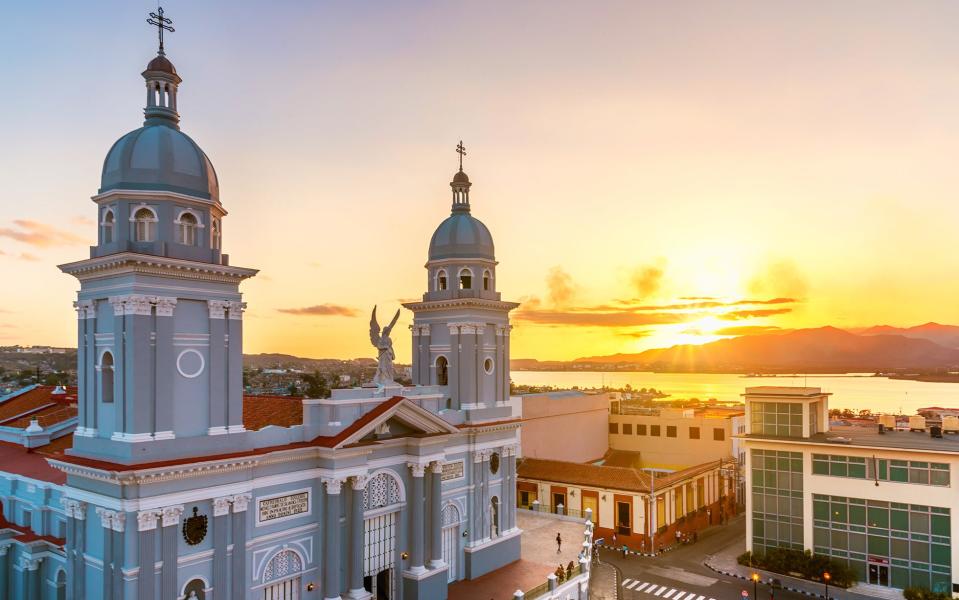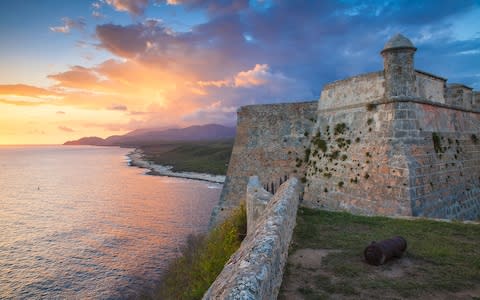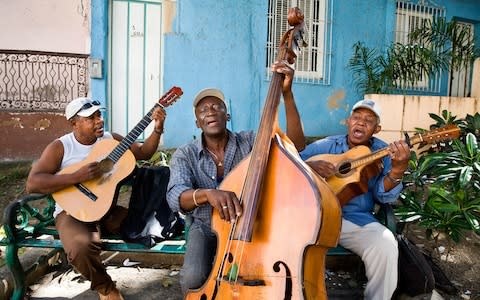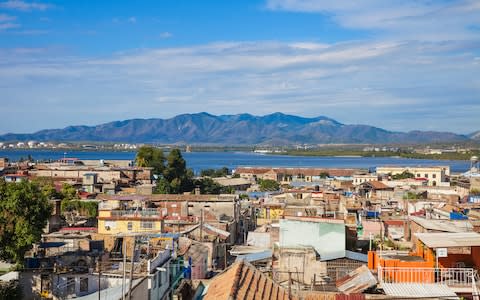Santiago de Cuba cruise port guide

Why go?
Sizzling Santiago is the most Caribbean of Cuba’s cities. Sloping up from the mountain-encircled Bay of Santiago, the 500-year-old city’s narrow, colourful Spanish colonial streets bulge with picturesque architecture, squares, and music haunts - all just a cocktail stick’s throw from the cruise port.
Santiago de Cuba is the birthplace of son, the percussion-driven predecessor to livelier salsa. Live music and dancing filter through the humid, historic streets. Fidel Castro, born near Santiago and schooled here, cemented the city’s reputation as the cradle of rebellion and revolution.
The daiquirí was invented here, and Bacardí rum born here. Superior Santiago Rum is made in the old Bacardí building near the railway terminal, not far from the cruise port. An increasing number of Cuba cruise itineraries are pulling in at Santiago.
Cruise port location
It couldn’t be better. Cruise ships dock at the terminal on Santiago’s bay opposite Calle Aguilera, west of the base of the historic city centre. Central Céspedes Park is 750 metres up a hill and takes around 15-20 minutes to walk. Cuban Revolution sites, for example, the Moncada Barracks Museum, are 1.25 miles away.

Can I walk to any places of interest?
The main sites of the historic city centre are all within walking distance but up a fairly steep hill to the core of the old city. Central Céspedes Park has multiple attractions within walking distance.
Getting around
Candela! Santiago is hot and humid. To take in the city’s historic sites in comfort, it makes sense to hire a classic car, taxi, or bicycle taxi. Hiring a bicitaxi from the port might mean temporarily getting off to allow the driver to pedal up the steep hill to the main Céspedes Park. Private transport can be found at the cruise port, and plenty of other city spots.

To take in the area’s other attractions such as El Cobre basilica (10 miles away), El Morro castle, (six miles), Gran Piedra mountain viewpoint, and Unesco-protected coffee plantation ruins (18 miles), San Juan Hill (three miles), and Santa Ifigenia Cemetery, where Fidel is buried (1.5 miles), you’ll need a taxi, or classic car.
Read more:Telegraph Travel's Havana cruise port guide
Read more: Telegraph Travel's Cienfuegos cruise port guide
Best beaches for cruise-ship visitors
Leave your swim gear on board. Santiago’s closest beach is not worth the trip. Siboney Beach, 11 miles from the city, shelters coarse, biscuit-coloured sand, and pebbles, and is crowded with Cuban families — especially at weekends. Private restaurants, and bars in the small hamlet, keep beachgoers entertained.
What to see and do?
Santiago is less about visiting every museum of history than it is about wandering the streets of a city brimming with street life, Spanish colonial buildings, craft markets, music venues, cocktail bars, monuments, and parks. Santiago was the 16th-century capital of Cuba, and an entrepôt of Haitian, African, and Jamaican cultural influences now reflected in its vibrant culture and Caribbean vibe.
Read more:Telegraph Travel's Caribbean Cruise Guide
What can I do in four hours or less?
The best way to see the historic core is to walk the narrow streets enjoying the atmosphere, history and music. Less-than-mobile visitors will want to hire taxis to visit the sites. Most taxi drivers have a smattering of English but not all can guide, but at each historic site, English-speaking guides can be hired. Cruise lines calling in at Santiago offer historic city tours but they are very expensive – a city tour with Azamara Club Cruises costs from £86.87.
Walk newly pedestrianised Calle Enramadas (José A Saco), exploring a craft market, shops and bars, and the architecturally curious chess café before turning right into central park with the Moorish interiors of the Museum of Cuban Historic Ambience, once the first Spanish governor’s home, and the oldest house in Cuba, the imposing 1922 cathedral, the people-watching terrace of Hotel Casa Grande, and the new coffee museum Casa Dranguet.

Amble Heredia Street with its artisans, Casa de la Trova, and music haunt Patio Artex. The Bacardi Museum holds an eye-boggling amount of artefacts collected by rum baron and one-time mayor of Santiago Emilio Bacardí Moreau including weaponry and an Egyptian mummy.
Rum connoisseurs can imbibe at the Rum Museum, in a beautiful townhouse, while learning more about rum making, Cuba’s different brands, and the best amber tipple on the island. History buffs will want to see the marble tombs of the Santa Ifigenia cemetery where Fidel Castro, José Martí, mastermind of Cuban independence, and Buena Vista Social Club superstar Compay Segundo have been laid to rest (expect queues to file past Castro’s rock tomb).
What can I do in eight hours or less?
Scope out more of Santiago’s historic sites, and pretty avenues, or take off from the city to explore history, nature, coffee, and views. Cuban Revolution students shouldn’t miss the Moncada Barracks where Fidel Castro launched a failed assault on July 26th 1953 setting him on the less-than-straight path to victory in 1959. The barracks-turned-museum provides good English-speaking guides. Snap the monumental statue to Cuban Independence leader Antonio Maceo on horseback, surrounded by 23 machetes.

More curious is the site of the only land battle in the Spanish-Cuban-American war of 1898 when the US muscled in on Cuba’s fight for freedom from Spain. Teddy Roosevelt formed a rag-tag army of Rough Riders, and charged up the San Juan Hill, on the edge of Santiago, routing the Spanish. The area is now a memorial park of monuments.
For tranquility, explore the French-influenced Tivolí neighbourhood looking out for the famous flight of picturesque steps, Padre Pico; and the handsome main avenue of the Vista Alegre neighbourhood, favourite 19th-century area of the city’s elite, with the fantastic Pioneers’ Palace, art nouveau homes, and new ceramic museum.
Key Santiago site is the Unesco-crowned 16th-century San Pedro de la Roca del Morro castle towering over the entrance to the Bay of Santiago. Gorgeous views, a piracy museum, and the wonderfully atmospheric cannon ceremony at sunset, plus the views on the road out to the headland, make this a favourite excursion.

From piracy to prayer at El Cobre: the statue representing Cuba’s patron saint, the Virgin of Charity of El Cobre, is housed in the country’s holiest shrine at the basilica of El Cobre outside of Santiago.
The wild wilderness of the Sierra Maestra Mountains slope skywards on the edge of the city. For panoramic Caribbean coast and views, and a good dose of high-altitude air climb the 459 steps to La Gran Piedra and stand atop the 1,200m-high boulder before walking on a further mile to the ruins-turned-museum of 19th-century French coffee plantation La Isabelica. Sip coffee on site to fuel that return to the ship.
Hire private transport for a more intimate take on Santiago. Plan stops and negotiate the price before setting off. Drivers charge per vehicle whereas cruise ship excursions, such as this Colonial Santiago tour from Royal Caribbean International, charge per person.
What can I do with a bit longer?
Santiago’s musical credentials are world class. Collect up those dancing shoes and head out to the Casa de la Trova where a roster of live music is posted at the door. Patio Artex, on Calle Heredia, also posts live music listings, as does Iris Jazz Club. The intimate atmosphere and live bands at Casa de las Tradiciones are worth seeking out but a taxi is handy as it’s difficult to find. Listings can be seen on http://promociones.egrem.co.cu. In Spanish only, see https://www.noticiasdesantiagodecuba.com/category/cartelera-cultural/ but listings are comprehensive. Worth seeking out are folkloric dance groups.

Eat and drink
Santiago’s private dining scene hasn’t yet had the boom of capital Havana so good food is a little harder to seek out. The city’s best restaurant is private St Pauli, on pedestrianised Enramadas, whose tasty fresh seafood dishes, and salads are moreish and moderately priced.
For sandwiches, cocktails and refreshing juices head to relaxed Rumba Café, not far from the central park. For local atmosphere take a seat in traditional coffee house, Café La Isabelica. Look out for the House of Pru to buy this famous eponymous eastern Cuba botanical brew — in a bottle to take away.
Don’t leave the island without…
For the city’s famous Ron Santiago tipple, head to the Museum of Rum, or Bar Barrita de Ron, next to the old Bacardí rum factory. For art, and hip souvenirs and crafts, browse the shops inside new Galería René Valdés in Vista Alegre. Shop for white cotton shirts and dresses at long established El Quitrín.

Need to know
Flight time
Flight time from the UK is 8-10 hours
Safety
Like any major city, take care of your belongings. Santiago is very safe. Beware of the touts (jineteros) who are persistent and numerous in Santiago. Cuban touts are very wearing but not dangerous. Such is their persistence that touts may come across as intimidating. Don’t be rushed, and negotiate firmly if hiring transport.
Best time to go
Hurricane season runs from June 1 until the end of October. Peak cruising season is November through to April.
Events
Events that draw visitors are the annual March International Pepé Sánchez Trova Festival (main venues include the Casa de la Trova, and Sala de Concierto Dolores), and the city’s wildly popular Festival del Caribe in early July, and carnival in late July. The annual International Matamoros Son Festival, dedicated to son, was held in May 2018 but has been held for many years in October. Festival Boleros, dedicated to romantic crooning, is held across the city in mid June every year. The next International Choir Festival will be staged October 29-November 3 2019.
Closures
Some museums are closed on Sundays or Sunday afternoons. Shopping hours vary.

